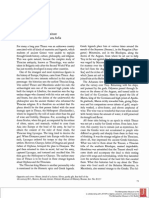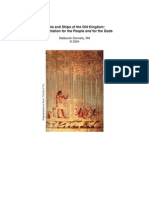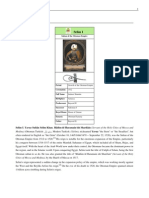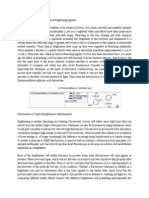Golden Fleece GFD
Golden Fleece GFD
Uploaded by
karahaydarCopyright:
Available Formats
Golden Fleece GFD
Golden Fleece GFD
Uploaded by
karahaydarOriginal Title
Copyright
Available Formats
Share this document
Did you find this document useful?
Is this content inappropriate?
Copyright:
Available Formats
Golden Fleece GFD
Golden Fleece GFD
Uploaded by
karahaydarCopyright:
Available Formats
Golden Fleece
Golden Fleece
In Greek mythology, the Golden Fleece (Greek: ; Georgian: ) is the fleece of the gold-haired[1] winged ram, which can be procured in Colchis. It figures in the tale of Jason and his band of Argonauts, who set out on a quest by order of King Pelias for the fleece in order to place Jason rightfully on the throne of Iolcus in Thessaly. The story is of great antiquity it was current in the time of Homer (eighth century BC) and, consequently, it survives in various forms, among which details vary. Thus, in later versions of the story, the ram is said to have been the offspring of the sea god Poseidon and Themisto (less often, Nephele or Theophane). The classic telling is the Argonautica of Apollonius of Rhodes, composed in mid-third century BC Alexandria, recasting early sources that have not survived. Another, much less-known Argonautica, using the same body of myth, was composed in Latin by Valerius Flaccus during the time of Vespasian.
Jason returns with the Golden Fleece on an Apulian red-figure calyx krater, ca. 340330 BCE
Synthesised plot synopsis
Athamas the Minyan, a founder of Halos in Thessaly[2] but also king of the city of Orchomenus in Boeotia (a region of southeastern Greece), took as his first wife the cloud goddess Nephele, by whom he had two children, the boy Phrixus and the girl Helle. Later he became enamored of and married Ino, the daughter of Cadmus, bringing drought upon his land when Nephele removed herself. Ino was jealous of her stepchildren and plotted their deaths: in some versions, she persuaded Athamas that sacrificing Phrixus was the only way to end the drought. Nephele, or her spirit, appeared to the children with a winged ram whose fleece was of gold.[3] The ram had been sired by Poseidon in his primitive ram-form upon a nymph, Theophane,[4] the granddaughter of Helios, the sun-god. According to Hyginus,[5] he carried her away to an island where he made her into an ewe so that he could have his way with her among the flocks, where Theophane's other suitors could not distinguish the ram-god and his consort.[6] On the ram the children escaped over the sea, but Helle fell off and drowned in the strait now named after her, the Hellespont. The ram spoke to Phrixus, giving him heart,[7] and took Phrixus, whose name means "curly"as ram's fleecesafely on to Colchis (modern-day Georgia), on the easternmost shore of the Euxine (Black) Sea. Phrixus then sacrificed the ram to Poseidon[8] and settled in the house of Aietes, son of Helios the sun-Titan, and lived to a ripe old age. He hung the Golden Fleece reserved from the sacrifice on an oak in a grove sacred to Ares, where it was guarded by a dragon. There it remained until taken by Jason. The ram became the constellation Aries.
Golden Fleece
Evolution of plot
The very early origin of the myth in preliterate times means that during the more than a millennium during which it was to some degree or other part of the fabric of culture its perceived significance can be expected to have passed through numerous developments. Pindar employed the quest for the Golden Fleece in his Fourth Pythian Ode (written in 462 BC), though the fleece itself is not in the foreground; when Aeetes challenges Jason to yoke the fire-breathing bulls, the fleece is the prize: "Let the King do this, the captain of the ship! Let him do this, I say, and have for his own the immortal coverlet, the fleece, glowing with matted skeins of gold".[9] Where the written sources fail, through accidents of history, sometimes the vase-painters preserve the continuity of a mythic tradition. It seems that the story of the Golden Fleece had little resonance for Athenians of the Classic age, for only two representations on Attic painted wares of the fifth century have been identified, a krater at the Metropolitan Museum of Art and a kylix in the Vatican collections.[10] In the kylix painted by Douris, ca 480-470, Jason is being disgorged from the mouth of the dragon, a detail that does not fit easily into the literary sources; behind the dragon, the fleece hangs from an apple tree. Jason's helper in the Athenian vase-paintings is not Medea who had an untoward history in Athens as the opponent of Theseus but Athena.
Interpretations
Euhemeristic attempts on the part of readers whose own cultural background dismisses the mythic fleece as a fanciful object have interpreted the Golden Fleece "realistically" as reflecting some actual cultural object or alleged historical practice grounded in economics: for example, in the twentieth century it was suggested that the story of the Golden Fleece signified the bringing of sheep husbandry to Greece from the east;[11] in other readings more schooled in mythology it would refer to golden grain,[12] or to the sun.[13] A more widespread interpretation relates it to a method of washing gold from streams that is well attested (but only from c. 5th century BC) in the region of Georgia to the east of the Black Sea. Sheep fleeces, sometimes stretched over a wood frame, would be submerged in the stream, and gold flecks borne down from upstream placer deposits would collect in them. The fleeces would then be hung in trees to dry before the gold was shaken or combed out. Alternatively, the fleeces would be used on washing tables in alluvial mining of gold or on washing tables at deep gold mines.[14] Judging by the very A sluice box used in placer mining. early gold objects from a range of cultures, washing for gold is a very old human activity. Thus Strabo describes the way in which gold could be washed: It is said that in their country gold is carried down by the mountain torrents, and that the barbarians obtain it by means of perforated troughs and fleecy skins, and that this is the origin of the myth of the golden fleeceunless they call them Iberians, by the same name as the western Iberians, from the gold mines in both countries. Another interpretation rests on references in some versions to purple or purple-dyed cloth. The purple dye extracted from snails of the Murex and related species was highly prized in ancient times, and clothing made of cloth dyed with Tyrian purple was a mark of great wealth and high station (hence the phrase royal purple). The association of gold with purple is thus natural and occurs frequently in the literature.[15]
Golden Fleece However, archeologists have rejected these interpretations as ahistorical. An attempt to construct a most plausible explanation by locating it in what is known of the culture in which the story arose points to the interpretation that the Golden Fleece represents the ideas of kingship and legitimacy; hence the journey of Jason to find it, in order to restore legitimate rule to Iolcos.[16]
Main theories
The following are the chief among the various explanations that have been offered, with notes on sources and major critical discussions: 1. It represents royal power. 1. Marcus Porcius Cato and Marcus Terentius Varro, Roman Farm Management (A Virginia Farmer (1918), Roman Farm Management, The Treatises of Cato and Varro, Done into English, with Notes of Modern Instances on-line text [17]) 2. Braund, David (1994), Georgia In Antiquity, Oxford: Clarendon Press, pp.21-23 3. Popko, M. (1974) Kult Swietego runa w hetyckiej Anatolii [The Cult of the Golden Fleece in Hittite Anatolia], Preglad Orientalistyczuy 91, pp.225-30 [In Russian]
Medea statue holding the Golden Fleece in the center of Batumi (One of the major cities of Colchis), Georgia.
4. Newman, John Kevin (2001) The Golden Fleece. Imperial Dream (Theodore Papanghelis and Antonios Rengakos (eds.). A Companion to Apollonius Rhodius. Leiden: Brill (Mnemosyne Supplement 217), 309-40) 5. Otar Lordkipanidze (2001), The Golden Fleece: Myth, Euhemeristic Explanation and Archaeology, Oxford Journal of Archaeology 20, pp.1-38 [18] 2. It represents the flayed skin of Krios (Ram), companion of Phrixus. 1. Diodorus Siculus 4. 47; cf. scholia on Apollonius Rhodius 2. 1144; 4. 119, citing Dionysus Argonautica 3. It represents a book on alchemy. 1. Palaephatus (fourth century BC) On the Incredible (Festa, N. (ed.) (1902) Mythographi Graeca III, 2, Lipsiae, p.89 4. It represents a technique of writing in gold on parchment. 1. Haraxes of Pergamum (c. first to sixth century) (Jacoby, F. (1923) Die Fragmente der griechischen Historiker I (Berlin), IIA, 490, fr. 37) 5. It represents a form of placer mining practiced in Georgia, for example. 1. Strabo (first century BC) Geography I, 2, 39 (Jones, H.L. (ed.) (1969) The Geography of Strabo (in eight volumes) London on-line text [19]) 2. Tran, T (1992) "The Hydrometallurgy of Gold Processing", Interdisciplinary Science Reviews (UK), 17, pp.356-365 3. "Gold During the Classical Period" [20] 4. Shuker, Karl P. N. (1997), From Flying Toads To Snakes With Wings, LLewellyn 5. Renault, Mary (2004), The Bull from the Sea, Arrow (Rand) 6. refuted in: Braund, David (1994), op. cit., p.24 and Otar Lordkipanidze (2001), op. cit. 6. It represents the forgiveness of God 1. Mller, Karl Otfried (1844), Orchomenos und die Minyer, Breslau 2. refuted in: Bacon, Janet Ruth (1925), The Voyage of the Argonauts, London: Methuen, p.64 ff, 163 ff 7. It represents a rain cloud. 1. Forchhammer, P. W. (1857) Hellenica Berlin p.205 ff, 330 ff 2. refuted in: Janet Ruth Bacon|Bacon, Janet Ruth (1925), op. cit.
Golden Fleece 8. It represents a land of golden grain. 1. Faust, Adolf (1898), Einige deutsche und griechische Sagen im Lichte ihrer ursprnglichen Bedeutung. Mulhausen 2. refuted in: Bacon, Janet Ruth (1925), op. cit. 9. It represents the spring-hero. 1. Schroder, R. (1899), Argonautensage und Verwandtes, Pozna 2. refuted in: Bacon, Janet Ruth (1925), op. cit. 10. It represents the sea reflecting the sun. 1. Vurthiem, V (1902), De Argonautarum Vellere aureo, Mnemosyne, New Series, XXX, pp.54-67; XXXI, p.116 2. Mannhardt, in Zeitschrift fr Ethnologie, VII, p.241 ff, 281 ff 3. refuted in: Bacon, Janet Ruth (1925), op. cit. 11. It represents the gilded prow of Phrixus ship. 1. Svoronos, M. (1914), in Journal International dArchologie Numismatique, XVI, pp.81-152 2. refuted in: Bacon, Janet Ruth (1925), op. cit. 12. It represents a breed of sheep in ancient Georgia. 1. Ninck, M. (1921), Die Bedeutung des Wassers im Kult und Leben der Alten, Philologus Suppl 14.2, Leipzig 2. Ryder, M.L. (1991) "The last word on the Golden Fleece legend?" Oxford Journal of Archaeology 10, pp.57-60 3. Smith, G.J. and Smith, A.J. (1992) Jason's Golden Fleece, Oxford Journal of Archaeology 11, pp.11920 13. It represents the riches imported from the East. 1. Bacon, Janet Ruth (1925), op. cit. 14. It represents the wealth or technology of Colchis. 1. Akaki Urushadze (1984), The Country of the Enchantress Medea, Tbilisi 2. Colchis [21] 3. Colchis, Land of the Golden Fleece [22] 15. It was a covering for a cult image of Zeus in the form of a ram. 1. Robert Graves (1944/1945), The Golden Fleece/Hercules, My Shipmate, New York: Grosset & Dunlap 16. It represents a fabric woven from sea silk. 1. 2. 3. 4. 5. Verrill, A. Hyatt (1950), Shell Collectors Handbook, New York: Putnam, p.77 Abbott, R. Tucker (1972), Kingdom of the Seashell, New York: Crown Publishers, p.184 History of Sea Byssus Cloth [23] Mussel Byssus Facts [24] refuted in:
1. Barber, Elizabeth J. W. (1991), Prehistoric textiles : the development of cloth in the Neolithic and Bronze Ages with special reference to the Aegean, Princeton, N.J. : Princeton University Press 2. McKinley, Daniel (1999), Pinna And Her Silken Beard: A Foray Into Historical Misappropriations, Ars Textrina 29, pp.9-29 17. It is about a voyage from Greece, through the Mediterranean, across the Atlantic to the Americas. 1. Bailey, James R. (1973), The God Kings and the Titans; The New World Ascendancy in Ancient Times, St. Martin's Press 18. It represents trading fleece dyed murex-purple for Georgian gold. 1. Silver, Morris (1992), Taking Ancient Mythology Economically, Leiden: Brill [25]
Golden Fleece
References
[1] [2] [3] [4] [5] [6] [7] , chrysomallos. Strabo, ix.5.8. That the ram was sent by Zeus was the version heard by Pausanias in the second century CE (Pausanias, ix.34.5). Theophane may equally be construed as "appearing as a goddess" or as "causing a god to appear" (Karl Kerenyi, The Heroes of the Greeks). Hyginus, Fabulae, 163 Karl Kerenyi The Gods of the Greeks, (1951) 1980:182f Upon the shield of Jason, as it was described in Apollonius' Argonautica, "was Phrixos the Minyan, depicted as though really listening to the ram, and the ram seemed to be speaking. As you looked on this pair, you would be struck dumb with amazement and deceived, for you would expect to hear some wise utterance from them with this hope you would gaze long upon them." (Richard Hunter, tr. Apollonius of Rhodes: Jason and the Golden Fleece, (Oxford University Press) 1993:21) [8] In essence this act returned the ram to the god, though in the surviving literary source, Apollonius' Argonautica ii, the ram was sacrificed to Zeus, rescuer of fugitives. [9] Translation in Nigel Nicholson, "Polysemy and Ideology in Pindar 'Pythian' 4.229-230" Phoenix 54.3/4 (Autumn-Winter 2000:191-202) p. 192. [10] Vatican 16545. Gisela Richter published the Metropolitan Museum's krater in "Jason and the Golden Fleece", American Journal of Archaeology 39 (1935); Cynthia King, "Who Is That Cloaked Man? Observations on Early Fifth Century B. C. Pictures of the Golden Fleece", American Journal of Archaeology 87.3 (July 1983:385-387). [11] Interpretation #12 [12] Interpretation #8 [13] Interpretation #10 [14] [15] [16] [17] [18] [19] [20] [21] [22] [23] [24] [25] Interpretation #5 Interpretation #17 Interpretation #1 http:/ / library. beau. org/ gutenberg/ 1/ 2/ 1/ 4/ 12140/ 12140-8. txt http:/ / www. ingentaconnect. com/ content/ bpl/ ojoa/ 2001/ 00000020/ 00000001/ art00121 http:/ / www. perseus. tufts. edu/ cgi-bin/ ptext?doc=Perseus%3Atext%3A1999. 01. 0239& loc=11. 2. 19 http:/ / www. minelinks. com/ alluvial/ goldClassic. html http:/ / www. lazuri. com/ kolheti/ en_index. php http:/ / www. great-adventures. com/ destinations/ rep_georgia/ colchis. html http:/ / www. designboom. com/ eng/ education/ byssus_history. html http:/ / www. lifesci. ucsb. edu/ mcdb/ labs/ waite/ byssus. html http:/ / members. tripod. com/ ~sondmor/ index-4. html
External links
The Project Gutenberg text of The Golden Fleece and the Heroes Who Lived Before Achilles (http://www. gutenberg.org/etext/2395)
Article Sources and Contributors
Article Sources and Contributors
Golden Fleece Source: http://en.wikipedia.org/w/index.php?oldid=465490497 Contributors: A Nobody, AS, Aaron north, Acalamari, Adoniscik, Adventeroux, Airplaneman, Alansohn, Alientraveller, Alsandro, Altenmann, Amit A., Andreas Philopater, Andreas Willow, Arjuna909, Arthurian Legend, BD2412, Bacchiad, Bart133, Bender235, Bibi Saint-Pol, Bikingshaun, Bill Oaf, Byrial, Canon, Catalographer, CatherineMunro, Charles Matthews, Che!, Cj1340, Closedmouth, Coolguy anish5, Courcelles, Crockett.jesse, Crystallina, Cuchullain, Czbiker, D.Papuashvili, D6, Danceswithzerglings, David.Monniaux, Deathphoenix, DogJesterExtra, Drdhaval2785, Egmontaz, Ehn, El Cubano, Ellsworth, Elsweyn, Epbr123, Evil Monkey, Falcon8765, Fredskis, Frencheigh, Geeman, GoonerDP, Hanzo66, Hydrargyrum, Isnow, J S Ayer, J.delanoy, JD554, JLROSENB, Jacomo, Jason Quinn, Jec, Jeffq, Jeronimo, Keraunos, Kusunose, Leuko, Levzur, Longsnout, Macrakis, Magnus Manske, Martg76, Maxamegalon2000, Mboverload, Michalis Famelis, Mintrick, Mitsukai, Modster, Mr. Stradivarius, Myscrnnm, Nickniko, Nsaa, Panda2005, Pasquale, Paxsimius, Pb30, Pearle, Peterlewis, PhnomPencil, Poindexter Propellerhead, Quentar, RadioFan, Raymondwinn, Redyka94, Rjwilmsi, RlyehRising, Rm, Rursus, Sebastian G., Selket, Severa, SinistralChirality, Sintaku, Snowolf, Soul assassin, SpaceFlight89, Stjeanp, Sus scrofa, Taborgate, Thatguyflint, Tillander, Timrollpickering, Tucci528, Turidoth, UnbelievableError, Vaxxxo, Velho, Vgy7ujm, Vrenator, Welhaven, Wetman, Wknight94, WojPob, Ysangkok, Ziga, 167 anonymous edits
Image Sources, Licenses and Contributors
Image:Jason Pelias Louvre K127.jpg Source: http://en.wikipedia.org/w/index.php?title=File:Jason_Pelias_Louvre_K127.jpg License: Public Domain Contributors: User:Jastrow Image:Placermine.jpg Source: http://en.wikipedia.org/w/index.php?title=File:Placermine.jpg License: Public Domain Contributors: USGS. Original uploader was Greenmountainboy at en.wikipedia Image:Medea statue in Batumi, Georgia.jpg Source: http://en.wikipedia.org/w/index.php?title=File:Medea_statue_in_Batumi,_Georgia.jpg License: Creative Commons Attribution 2.0 Contributors: Paata Vardanashvili from Tbilisi, Georgia
License
Creative Commons Attribution-Share Alike 3.0 Unported //creativecommons.org/licenses/by-sa/3.0/
You might also like
- Parzival 1Document6 pagesParzival 1karahaydarNo ratings yet
- Archaeological and Geographic Evidence For The Voyage of WenamunDocument36 pagesArchaeological and Geographic Evidence For The Voyage of WenamunDebborah Donnelly100% (2)
- Manga Manía Occult and HorrorDocument146 pagesManga Manía Occult and HorrorFranco100% (5)
- Seasons for the Soul - Spells of Nature: The Embroidered Art of Julia van den BoschFrom EverandSeasons for the Soul - Spells of Nature: The Embroidered Art of Julia van den BoschNo ratings yet
- Key to Chivalry: Fairy Tale with Teacher and Parenting Social Emotional Learning SkillsFrom EverandKey to Chivalry: Fairy Tale with Teacher and Parenting Social Emotional Learning SkillsNo ratings yet
- December's Child: A Book of Chumash Oral NarrativesFrom EverandDecember's Child: A Book of Chumash Oral NarrativesRating: 4.5 out of 5 stars4.5/5 (2)
- Geek Parenting: What Joffrey, Jor-El, Maleficent, and the McFlys Teach Us about Raising a FamilyFrom EverandGeek Parenting: What Joffrey, Jor-El, Maleficent, and the McFlys Teach Us about Raising a FamilyRating: 3.5 out of 5 stars3.5/5 (5)
- Guided By The Goddess - Finnish Wheel Of The Year: Finnish Mythology With Fairychamber, #2From EverandGuided By The Goddess - Finnish Wheel Of The Year: Finnish Mythology With Fairychamber, #2No ratings yet
- The Golden Fleece and the Heroes Who Lived Before Achilles (Illustrated Edition): Greek Myths & Legends - Retold for ChildrenFrom EverandThe Golden Fleece and the Heroes Who Lived Before Achilles (Illustrated Edition): Greek Myths & Legends - Retold for ChildrenNo ratings yet
- Otar LordkipanidzeDocument38 pagesOtar LordkipanidzeGrem Lin100% (1)
- Winter I. J. 1995 - Homers Phoenicians H PDFDocument26 pagesWinter I. J. 1995 - Homers Phoenicians H PDFvalentinoNo ratings yet
- Jason and The Golden Fleece. - InvestigationDocument4 pagesJason and The Golden Fleece. - InvestigationAntoSeitanNo ratings yet
- Chronology of TroyDocument8 pagesChronology of TroyeengelbriteNo ratings yet
- (DKM 2021-08) Ophir and PuntDocument12 pages(DKM 2021-08) Ophir and PuntDon MillsNo ratings yet
- PindarDocument1 pagePindarAnonymous RY91UFyQNo ratings yet
- The Argonauts: Apollonius of RhodesDocument2 pagesThe Argonauts: Apollonius of RhodesÑìkhíl GãürâvNo ratings yet
- Astronomical Reflexes in Ancient CoinsDocument30 pagesAstronomical Reflexes in Ancient CoinsAnitaVasilkovaNo ratings yet
- Bulgaria Venedikov TextDocument72 pagesBulgaria Venedikov Textomnisanctus_new0% (1)
- THracian Thalassocraynewa PDFDocument11 pagesTHracian Thalassocraynewa PDFMaria Pap.Andr.Ant.No ratings yet
- DaciiDocument40 pagesDaciiCezar Partheniu100% (1)
- The Necklace of HarmoniaDocument62 pagesThe Necklace of HarmoniazeusNo ratings yet
- Amasis and LindosDocument12 pagesAmasis and Lindossychev_dmitryNo ratings yet
- WA2.2 Assignment 4Document4 pagesWA2.2 Assignment 4Floor RoeterdinkNo ratings yet
- Aunu PeopleDocument4 pagesAunu PeopleSheryl MillerNo ratings yet
- Borza 1993, The Philhellenism of ArchelausDocument8 pagesBorza 1993, The Philhellenism of Archelausgordianknot2020No ratings yet
- Jonathan Gray - Ten Amazing Secrets From Lost Cities PDFDocument11 pagesJonathan Gray - Ten Amazing Secrets From Lost Cities PDFjeronymomonteiroNo ratings yet
- Σκύλαξ,Skylax KaryandaDocument20 pagesΣκύλαξ,Skylax KaryandaGeorgiosXasiotisNo ratings yet
- Midas ManualDocument4 pagesMidas ManualNaveenkumarNo ratings yet
- The Tomb of The Argonautes at Elkab in Egypt (1120 B.C.) (ENGLISH)Document20 pagesThe Tomb of The Argonautes at Elkab in Egypt (1120 B.C.) (ENGLISH)six13840No ratings yet
- 2 The Prehistoric PeriodDocument10 pages2 The Prehistoric PeriodPetraNo ratings yet
- Yoyotte - GUARDIAN OF THE NILE - THÔNIS REDISCOVEREDDocument3 pagesYoyotte - GUARDIAN OF THE NILE - THÔNIS REDISCOVEREDPiero PizziconiNo ratings yet
- Bulgaria VenedikovDocument11 pagesBulgaria Venedikovberberian00No ratings yet
- Vol 17 Article 4Document11 pagesVol 17 Article 4alcaeusapphoNo ratings yet
- Anne Farkas - Style and Subject Matter in Native Thracian ArtDocument16 pagesAnne Farkas - Style and Subject Matter in Native Thracian ArtCodrin BucurNo ratings yet
- Work Notes On The Phrygian TextsDocument22 pagesWork Notes On The Phrygian TextsAtraNo ratings yet
- Personification of Landscape in The Works of Pindar and Thomas HardyDocument11 pagesPersonification of Landscape in The Works of Pindar and Thomas HardylightguarderNo ratings yet
- The Bearing of Inscriptions On Classical LiteratureDocument21 pagesThe Bearing of Inscriptions On Classical LiteratureEvangelosNo ratings yet
- Thracians: Lionel Casson Chairman Department of Classics New York UniversityDocument5 pagesThracians: Lionel Casson Chairman Department of Classics New York UniversityIvo YonovskiNo ratings yet
- The Crown of Naxos / (R. Ross Holloway)Document11 pagesThe Crown of Naxos / (R. Ross Holloway)Digital Library Numis (DLN)No ratings yet
- Minoans and Mycenaeans EssayDocument16 pagesMinoans and Mycenaeans Essaymat9343No ratings yet
- Bromehead - Aetites or The Eagle-StoneDocument10 pagesBromehead - Aetites or The Eagle-StonerbrtfNo ratings yet
- Boats and Ships of The Old Kingdom: Transportation For The People and For The GodsDocument35 pagesBoats and Ships of The Old Kingdom: Transportation For The People and For The GodsDebborah DonnellyNo ratings yet
- The Cult of HeliosDocument25 pagesThe Cult of HeliosIsrael CamposNo ratings yet
- A1. Coldstream 1976Document10 pagesA1. Coldstream 1976Emil KmeticNo ratings yet
- The Saga of The Argonauts A Reflex of TH PDFDocument11 pagesThe Saga of The Argonauts A Reflex of TH PDFruja_popova1178No ratings yet
- Selim 1Document6 pagesSelim 1karahaydar100% (1)
- Osman 1Document6 pagesOsman 1karahaydarNo ratings yet
- ZhengheDocument1 pageZhenghekarahaydarNo ratings yet
- Cautionary Tales For Children - BellocDocument5 pagesCautionary Tales For Children - Bellocwayneferguson100% (1)
- Read The Runesmith Chapter 101 Future Plans. Online For Free - ReadNovelFullDocument21 pagesRead The Runesmith Chapter 101 Future Plans. Online For Free - ReadNovelFullgosukenshinNo ratings yet
- Donna Core Ben Fall Ai 18Document17 pagesDonna Core Ben Fall Ai 18Europont PapraviadiNo ratings yet
- Us1955360 PDFDocument8 pagesUs1955360 PDFRodrigoPomaNo ratings yet
- Use Rounding To Check Answers (Year 5) Full Colour - M2WAC1293Document8 pagesUse Rounding To Check Answers (Year 5) Full Colour - M2WAC1293Meriam KasraouiNo ratings yet
- Assignment PacDocument3 pagesAssignment PacChen LilyNo ratings yet
- My Secret Wanderlust - Alexa RileyDocument57 pagesMy Secret Wanderlust - Alexa Riley8bnngfy6c6No ratings yet
- Historical Development of Optical Brightening AgentsDocument2 pagesHistorical Development of Optical Brightening AgentsvishvajitjNo ratings yet
- Back To You VegasPeteDocument67 pagesBack To You VegasPeteAzalea SmithNo ratings yet
- Survival MalteseDocument48 pagesSurvival Malteseelektrologos100% (1)
- Project On Fixed Assets ManagementDocument103 pagesProject On Fixed Assets ManagementChintan Desai80% (5)
- Total Productive Maintenance in RMG SectorDocument4 pagesTotal Productive Maintenance in RMG SectorHarsh RajNo ratings yet
- (1904) Old English FurnitureDocument272 pages(1904) Old English FurnitureHerbert Booker100% (4)
- 168 Slalom Hat For Download PDFDocument2 pages168 Slalom Hat For Download PDFNhung VuNo ratings yet
- Reviewer in English, LapgDocument9 pagesReviewer in English, LapgRichardRaquenoNo ratings yet
- A1.1 Unit 7 PDFDocument3 pagesA1.1 Unit 7 PDFMELANY ANDREA OTALORA RODRIGUEZNo ratings yet
- Coo - 2019clothing The ColonyDocument570 pagesCoo - 2019clothing The ColonytintinalcongoNo ratings yet
- Julian Fellowes' S BelgraviaDocument341 pagesJulian Fellowes' S Belgraviaalexegeorgeta13100% (4)
- The Adventure of Ibn BattutaDocument6 pagesThe Adventure of Ibn Battutaعبد الحكيمNo ratings yet
- English Download A2 Unit 2 Test: The Past in Another CountryDocument2 pagesEnglish Download A2 Unit 2 Test: The Past in Another CountryTadeo GarcíaNo ratings yet
- Unisex Scrubs Pants Pattern PayhipDocument29 pagesUnisex Scrubs Pants Pattern PayhipPRISCILA VANESSA GARCIA REMACHENo ratings yet
- 8 June 16Document4 pages8 June 16Sandra Liliana Paez MoralesNo ratings yet
- Young Folks Treasury-4Document40 pagesYoung Folks Treasury-4msergiostNo ratings yet
- Process Parameter in Blow RoomDocument19 pagesProcess Parameter in Blow RoomakmaluzirNo ratings yet
- ExportDocument44 pagesExportMuller RezqNo ratings yet
- Manual Pajero 4x4 Rear AxleDocument32 pagesManual Pajero 4x4 Rear AxleGIAN CARLO MAMANI GILES.No ratings yet
- Rydal-Penrhos SchoolDocument1 pageRydal-Penrhos SchoolAlexander CurzonNo ratings yet
- Cumulative Review Chapter 7 and 8 PDFDocument4 pagesCumulative Review Chapter 7 and 8 PDFSilancem0% (1)




























































































